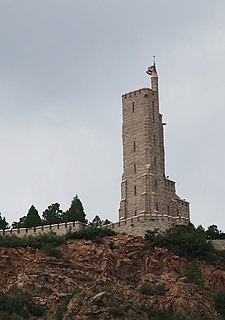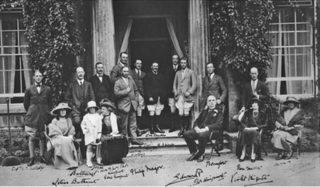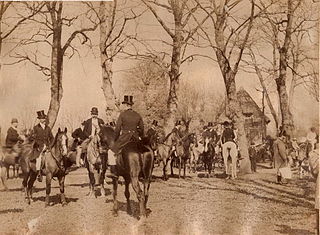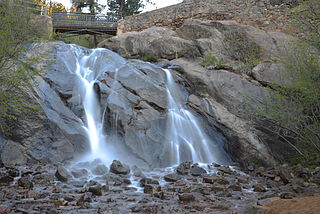Related Research Articles

The Broadmoor is a hotel and resort in the Old Broadmoor neighborhood of Colorado Springs, Colorado. The Broadmoor is a member of Historic Hotels of America of the National Trust for Historic Preservation. Its visitors have included heads of state, celebrities, and professional sports stars.
A polo handicap is a system created by Henry Lloyd Herbert, the first president of the United States Polo Association, at the founding of the USPA in 1890 so teams could be more evenly matched when using players with varying abilities.
Claire Janet Tomlinson is an English polo player and pony breeder. She was the highest-rated female polo player, and coached the English national team she once captained.

Will Rogers Shrine of the Sun, also known as Will Rogers Shrine, is a commemorative tower and chapel on Cheyenne Mountain in Colorado Springs, Colorado. It is named after Will Rogers, the American humorist, who died in a plane crash in Alaska in 1935 during construction of the shrine. It is also a tomb for the remains of Spencer Penrose – who built many of the city's prominent properties, including the neighboring Cheyenne Mountain Zoo and The Broadmoor resort – and his wife Julie. Completed by Penrose in 1937, the shrine is a 100 feet (30 m), five story observation tower that overlooks The Broadmoor, Colorado Springs, and Garden of the Gods.

James John (J.J.) Hagerman was an American industrialist who owned mines, railroads and corporate farms in the American West in the late 19th and early 20th centuries. He was one of the most influential men in territorial New Mexico.

Before it was founded, the site of modern-day Colorado Springs, Colorado, was part of the American frontier. Old Colorado City, built in 1858 during the Pike's Peak Gold Rush was the Colorado Territory capital. The town of Colorado Springs, was founded by General William Jackson Palmer as a resort town. Old Colorado City was annexed into Colorado Springs. Railroads brought tourists and visitors to the area from other parts of the United States and abroad. The city was noted for junctions for seven railways: Denver and Rio Grande (1870), Denver and New Orleans Manitou Branch (1882), Colorado Midland (1886-1918), Colorado Springs and Interurban, Atchison, Topeka, and Santa Fe (1889), Rock Island (1889), and Colorado Springs and Cripple Creek Railways. It was also known for mining exchanges and brokers for the Cripple Creek Gold Rush.

John Arthur Edward Traill (1882–1958) was the first Irish–Argentine 10-goal polo player.

Major Philip Magor (1881–1971), was a British polo player and patron of the Panthers Polo Team as well as owner of La Estrella Ranch in Argentina. Magor and the Panthers won the Roehampton Trophy.

Leslie Cheape (1882–1916) was a British soldier and famous polo player in the 1910s
The Museum of Polo and Hall of Fame is a 501(c)(3), non-profit organization to celebrate the sport of polo.

William Knapp Thorn, Jr. was an American champion polo player and the grandson of Commodore Cornelius Vanderbilt. Also, he was a hunter and horse-rider. He was one of the best-known sportsmen in the United States and France.

The Cheyenne Mountain Highway, also called Cheyenne Mountain Zoo Road, is a road in Colorado Springs, Colorado that begins at the intersection of Penrose Boulevard, Old Stage Road, and West Cheyenne Mountain Boulevard. It is a paved road to the Cheyenne Mountain Zoo and Will Rogers Shrine of the Sun. Thereafter, it is an unpaved private road to the summit, known as The Horns.

Chester Alan Arthur II, also known as Alan Arthur, was a son of President Chester A. Arthur. He studied at Princeton University and Columbia University's Law School. After completing his studies, Arthur traveled throughout Europe for 10 years. In 1900 he married in Switzerland and moved to Colorado Springs, Colorado to improve his health.

Stephen Sanford was an American polo champion and owner of Thoroughbred racing horses.

The El Pomar Estate was the Penrose House and estate of Spencer and Julie Penrose in the Broadmoor, Colorado, Colorado Springs, Colorado It is listed on the National Register of Historic Places listings in El Paso County, Colorado and the Colorado State Register of Historic Properties.

Broadmoor is a neighborhood in Colorado Springs, Colorado.

Cheyenne Creek is a stream in Colorado Springs, El Paso County, Colorado at 5,920 feet (1,800 m) in elevation. The stream is fed by the North Cheyenne Creek and South Cheyenne Creek and flows into Fountain Creek near Nevada Avenue, between Interstate 25 and the Pikes Peak Greenway trail. North Cheyenne Creek and South Cheyenne Creek flow through Teller and El Paso Counties. The source of South Cheyenne Creek is Mount Big Chief, near St. Peter's Dome, and it flows to Seven Falls.

Cheyenne Mountain is a triple-peaked mountain in El Paso County, Colorado, southwest of downtown Colorado Springs. The mountain serves as a host for military, communications, recreational, and residential functions. The underground operations center for the North American Aerospace Defense Command (NORAD) was built during the Cold War to monitor North American airspace for missile launches and Soviet military aircraft. Built deep within granite, it was designed to withstand the impact and fallout from a nuclear bomb. Its function broadened with the end of the Cold War, and then many of its functions were transferred to Peterson Air Force Base in 2006.
Captain Geoffrey Stanley Phipps-Hornby was a British Army officer and polo player.
The Cambridge University Polo Club is the Discretionary Full Blue sports club for competitive polo at Cambridge University. Founded in 1873, it is the oldest surviving polo club in Europe and the second oldest in the world. Its annual Varsity Match against Oxford, established in 1878, is the oldest continuing polo fixture in the world.
References
- 1 2 3 4 Steve Bogener (2003). Ditches Across the Desert: Irrigation in the Lower Pecos Valley . Texas Tech University Press. p. 30. ISBN 978-0-89672-509-6 . Retrieved 10 June 2013.
- 1 2 3 4 5 6 7 Horace A. Laffaye (March 2011). Polo in the United States: A History. McFarland. pp. 37–38. ISBN 978-0-7864-8007-4 . Retrieved June 11, 2013.
- ↑ Steve Bogener (2003). Ditches Across the Desert: Irrigation in the Lower Pecos Valley . Texas Tech University Press. p. 41. ISBN 978-0-89672-509-6 . Retrieved 10 June 2013.
- ↑ Horace A. Laffaye (March 2011). Polo in the United States: A History. McFarland. p. 82. ISBN 978-0-7864-8007-4 . Retrieved June 11, 2013.
- ↑ Horace A. Laffaye (March 2011). Polo in the United States: A History. McFarland. p. ix. ISBN 978-0-7864-8007-4 . Retrieved June 11, 2013.